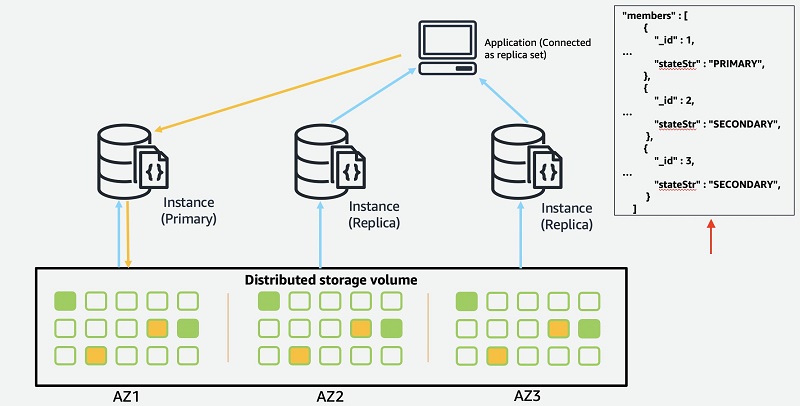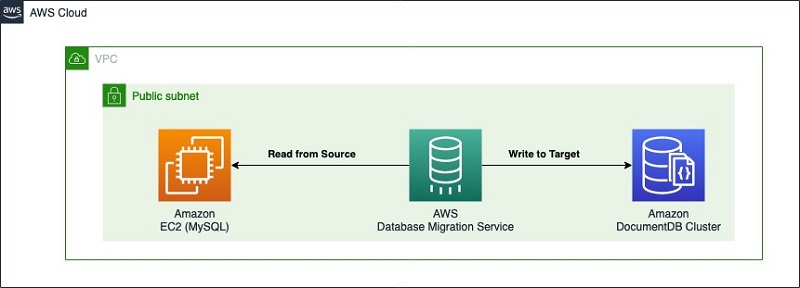AWS Database Blog
Tag: Amazon DocumentDB (with MongoDB Compatibility)
Building resilient applications with Amazon DocumentDB (with MongoDB compatibility), Part 1: Client configuration
Amazon DocumentDB (with MongoDB compatibility) is a fast, scalable, highly available, and fully managed document database service that supports MongoDB workloads. You can use the same MongoDB 3.6, 4.0 or 5.0 application code, drivers, and tools to run, manage, and scale workloads on Amazon DocumentDB without worrying about managing the underlying infrastructure. As a document […]
Monitoring metrics and setting up alarms on your Amazon DocumentDB (with MongoDB compatibility) clusters
Amazon DocumentDB (with MongoDB compatibility) is a fast, scalable, highly available, and fully managed document database service that supports MongoDB workloads. You can use the same MongoDB 4.0 or 5.0 application code, drivers, and tools to run, manage, and scale workloads on Amazon DocumentDB without having to worry about managing the underlying infrastructure. As a […]
Amazon DocumentDB (with MongoDB compatibility) read autoscaling
Amazon Document DB (with MongoDB compatibility) is a fast, scalable, highly available, and fully managed document database service that supports MongoDB workloads. Its architecture supports up to 15 read replicas, so applications that connect as a replica set can use driver read preference settings to direct reads to replicas for horizontal read scaling. Moreover, as […]
Announcing the Amazon DocumentDB (with MongoDB compatibility) workshop
Amazon DocumentDB (with MongoDB compatibility) is a fast, scalable, highly available, and fully managed document database service that supports MongoDB workloads. You can use the same MongoDB 3.6, 4.0 or 5.0 application code, drivers, and tools to run, manage, and scale workloads on Amazon DocumentDB without worrying about managing the underlying infrastructure. As a document […]
Getting started with Amazon DocumentDB (with MongoDB compatibility); Part 4 – using Amazon SageMaker notebooks
In this post, we demonstrate how to use Amazon SageMaker notebooks to connect to Amazon DocumentDB for a simple, powerful, and flexible development experience. We walk through the steps using the AWS Management Console, but also include an AWS CloudFormation template to add an Amazon SageMaker notebook to your existing Amazon DocumentDB environment.
Migrating relational databases to Amazon DocumentDB (with MongoDB compatibility)
If your data is stored in existing relational databases, converting relational data structures to documents can be complex and involve constructing and managing custom extract, transform, and load (ETL) pipelines. Amazon Database Migration Service (AWS DMS) can manage the migration process efficiently and repeatably. With AWS DMS, you can perform minimal downtime migrations, and can replicate ongoing changes to keep sources and targets in sync. This post provides an overview on how you can migrate your relational databases like MySQL, PostgreSQL, Oracle, Microsoft SQL Server, and others to Amazon DocumentDB using AWS DMS.
Introducing MongoDB 4.0 compatibility and Transactions in Amazon DocumentDB
This post summarizes what’s new in Amazon DocumentDB 4.0 and show you how to get started with Amazon DocumentDB 4.0 and transactions using an AWS Cloud9 environment.
Profiling slow-running queries in Amazon DocumentDB (with MongoDB compatibility)
Amazon DocumentDB (with MongoDB compatibility) is a fast, scalable, highly available, and fully managed document database service that supports MongoDB workloads. You can use the same MongoDB 3.6 application code, drivers, and tools to run, manage, and scale workloads on Amazon DocumentDB without having to worry about managing the underlying infrastructure. As a document database, Amazon DocumentDB makes it easy to store, query, and index JSON data. AWS built Amazon DocumentDB to uniquely solve your challenges around availability, performance, reliability, durability, scalability, backup, and more. In doing so, we built several tools, like the profiler, to help you run analyze your workload on Amazon DocumentDB. The profiler gives you the ability to log the time and details of slow-running operations on your cluster. In this post, we show you how to use the profiler in Amazon DocumentDB to analyze slow-running queries to identify bottlenecks and improve individual query performance and overall cluster performance.
Using cost allocation tags with Amazon DocumentDB (with MongoDB compatibility)
Amazon DocumentDB (with MongoDB compatibility) is a fast, scalable, highly available, and fully managed document database service that supports MongoDB workloads. You can use the same MongoDB 3.6, 4.0 or 5.0 application code, drivers, and tools to run, manage, and scale workloads on Amazon DocumentDB without having to worry about managing the underlying infrastructure. As […]
Backing up data with Amazon DocumentDB (with MongoDB compatibility)
Amazon DocumentDB (with MongoDB compatibility) is a fast, scalable, highly available, and fully managed document database service that supports MongoDB workloads. You can use the same MongoDB 3.6 or 4.0 application code, drivers, and tools to run, manage, and scale workloads on Amazon DocumentDB without worrying about managing the underlying infrastructure. As a document database, […]









